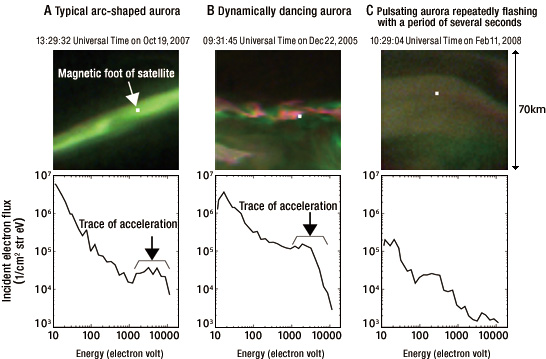TOP > Report & Column > The Forefront of Space Science > 2010 > New Aurora Shape Captured by REIMEI
![]()

A camera and particle analyzer onboard the Innovative Technology Demonstration Experiment satellite REIMEI discovered a structurally unique aurora (Northern Lights) with different properties from previously observed ones. This article outlines the discovery. Mechanism of aurora generation Before introducing the discovered nature of aurora, I would like to briefly explain the generation mechanism of aurora. An aurora is a phenomenon where the atmosphere emits light between 90 to 300 km above the ground. It is caused by precipitating energetic particles that collide with the earths upper atmosphere. The auroras shape is determined by the spatial distribution of the particles entering the upper atmosphere. If the distribution of incident particles was even and stable, the resulting aurora would shine evenly in the night sky and would not attract our attention so much. The question why does aurora occur?Ecan be restated with why do high-energy particles enter the atmosphere?EA clue to answer the question is provided by simultaneous observation of the aurora and the incident particles causing it. We have to fulfill three very difficult conditions to realize simultaneous observation by ground-observation station and satellite. First, aurora appears over the ground-observation station. Secondly, there is no cloud to block auroral light. Thirdly, the satellite passes through the sky over the station. This is just a matter of luck, and cases of simultaneous observation are so rare. Launched in August 2005, REIMEI thoroughly settled this difficult problem. At an altitude of around 630 km, REIMEI observed the incident particles causing the aurora while simultaneously capturing the fine structure of aurora from above, undisturbed by cloud, with a high-sensitivity CCD camera. Simultaneous observation of aurora and particles Fig.1 shows examples of simultaneous observation of an aurora and particles by REIMEI. Aurora A at left is a typical arc-shaped aurora. The lower diagram shows the energy distribution of incident electron flux, indicating a monotonic decrease in the flux with energy at energy less than 1,000 electron volts; however, at energy greater than that, we can see a hump. This hump is a manifestation of the electrons that were accelerated in the direction of the magnetic lines toward the earth. The incident electrons with energy greater than about 1,000 electron volts made primarily the green aurora. From the peak energy of the hump, it is found that electrons were accelerated downward by potential difference of several 1,000 volts along a magnetic field line. 
|
||||||




